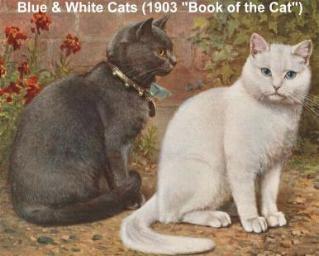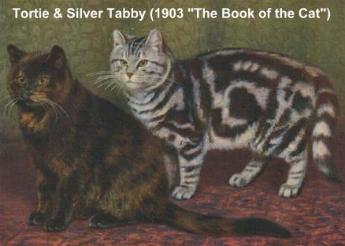
SHORTHAIRED CATS OF THE 19TH CENTURY - HELEN WINSLOW
CONCERNING VARIETIES OF CATS - SHORTHAIRS
Concerning Cats (1900, Helen Winslow)

American Helen M Winslow was the editor of "The Club Woman" and the author of "Concerning Cats" (published 1900), a book on cats and the cat fancy in America. At that time, the American cat fancy lagged greatly behind the British scene and her comments are less extensive than those of Frances Simpson a few years later (her comments on "Australian" cats comes form another part of her book and is included elsewhere in this article).
Few people realize how many kinds of Cats there are. The fashionable world begins to discuss cats technically and understand their various points of excellence. The "lord mayorís chain," the "Dutch rabbit markings," and similar features are understood by more cat fanciers than a few years ago; but, until within that time, it is doubtful if the number of people who knew the difference between the Angora and the Persian in this country amounted to a hundred. It is but a few years since the craze for the Angora cat started. These cats have been fashionable pets in England for some years back, and now America begins to understand their value and the principles of breeding them. Today, there are as handsome, well-bred animals in the United States as can be found abroad. The demand for high-bred animals with a pedigree is greatly increasing, and society people are beginning to understand the fine points of the thoroughbred.
[Following from a description of Russian Longhairs] There is also a fine short-haired cat coming from Russia, usually self-colored. Mrs. Frederick Monroe, of Chicago, owns a very handsome blue and white one.
In Pegu, Siam, and Burmah, there is a race of cats known as the Malay cat, with tails only half the ordinary length and often contorted into a sort of a knot that cannot be straightened, after the fashion of the pug dog or ordinary pig. There is another cat known as the Mombas, a native of the west coast of Africa and covered with stiff, bristling hair. Paraguay cats are only one-quarter as big as our ordinary cat, and are found along the western coast of South America, even as far north as Mexico.[Ö] In Australia, New Zealand, and New Guinea there used to be no cat of any kind. The Siamese cat has been imported to Australia, and some authorities claim that the cats known in this country as Australian cats are of Siamese origin. Madagascar is a catless region.
The royal cat of Siam is a short-haired cat, yet widely different from other short-haired varieties. They are extremely pretty, with blue or amber-colored eyes by day which grow brilliant at night. These cats also frequently have the kink in the tail, and sometimes a strong animal odor, although this is not disagreeable. The head is rather longer than the ordi≠nary catís, tapering off sharply toward the muzzle, the forehead flat and receding, and the eyes more slanting toward the nose than the American catís. The form should be slender, graceful, and delicately made; the body long; the tail very thin and rather short; the legs short and slender, and the feet oval. The body is of a bright, uniform color, and the legs, feet, and tail are usually black.
The Manx cat is considered by many people as a natural curiosity. It differs from the ordinary domestic cat but little, except in the absence of a tail, or even an apology for one. The hind legs are thicker and rather longer than the ordinary catís, and it runs more like a hare. It is not a graceful object when seen from behind, but it is an affectionate, home-loving creature with considerable intelligence. The Manx cat came from the Isle of Man originally, and is a distinct breed. So-called Manx cats have tails from one to a few inches long, but these are crosses of the Manx and the ordinary cat. In the Crimea is found another kind of cat which has no tail. The cats known as the "celebrated orange cats of Venice," are probably descendants of the old Egyptian cat, and are of varying shades of yellow, sometimes deepening into a sandy color which is almost red. There are obscure stripes on the body, which become more distinct on the limbs. The tail is more or less ringed toward its termination.

There has been a newspaper paragraph floating about stating that a prize of several thousand dollars had been offered in England for a male tortoise-shell cat. This is probably not true, as a Mr. Smith exhibited a tortoise-shell he-cat at the Crystal Palace Show of 1871. Several tortoise-shell and white toms have been exhibited since, and one of these has taken nine first prizes at the Crystal Palace Show; but the tortoise-shell he-cat is extremely rare. The real tortoise-shell is not a striped tiger nor a tabby. It has three colors usually, black, yellow, and red or brown; but these appear in patches rather than stripes. It is said that the tortoise-shell cat is common in Egypt and the south of Europe. It comes from a different stock than the ordinary short-haired cat, the texture of the hair being different, as well as the color. The tortoise-shell and white cat is much more common, and is the product of a cross between a tortoise shell and a solid color cat. In this case the hair is usually coarser and the tail thicker than in the ordinary cat. Among cat fanciers there is a distinctive variety known as the tortoise-shell tabby. As the tabby cat is one of the varieties of striped or spotted cats having markings, broad or narrow, of bands of black on a dark tan or gray ground, the tortoise-shell cat would have both stripes and patches of color.
Of the tabbies, there are brown tabbies, silver tabbies, and red tabbies. It is said that the red tabby she-cat is as scarce as the tortoise-shell he-cat. The ordinary observer considers the brown tabby with white markings as much the handsomest of the tabbies. But fanciers and judges do not agree with him, the cats having narrow bands and spots being the ones to take prizes. The word "tabby," according to Harrison Weir, was derived from a kind of taffeta or ribbed silk which used to be called tabby silk. Other authorities state that tabby cats got their name from Atab, a street in Bagdad; but as this street was famous for its watered silks perhaps the same reason holds. The tortoise-shell used to be called, in England, the Calimanco. In America, it is sometimes called the calico cat.
The red tabby is of a deep reddish or yellow brown, with a well-ringed tail, orange or yellow eyes, and pink cushions to the feet. The brown tabby is orange brown, with black lips, brown whiskers, black feet, black pads, long tail, greenish orange eyes, and red nose bordered with black. The spotted tabby must have no bands at all. It must be brown, red, or yellow, with black spots. In the brown tabby the feet and pads are black; in the yellow and red, the feet and pads are pink. The spotted cat sometimes resembles a leopard, while the banded tabby resembles more the tiger. Some of the spotted tabbies are extremely handsome, and came originally from a cross between the ordinary cat and the wild cat.
"Self-colored cats" are entirely of one color, which may vary in different cats, but must never be mixed in the same cat, nor even shaded into a lighter tone on the animal; and whether this color be black, blue, red, or yellow, the self-colored cat should have a rich deep tint. Of course the short-haired white cat is the handsomest of all. One of the peculiarities of this white cat is that it is apt to be deaf. The most valuable white cats, whether long or short haired, have blue eyes. Sometimes they have one blue eye and one green or yellow, which gives a comical effect, and detracts from their value. By the way, cross-eyed cats are not unknown. The best white cats have a yellowish white tint instead of grayish white, as the latter have a coarser quality of fur.
The jet-black cat is thought by many to be the most desirable. The true black cat should have a uniform, intensely black coat, velvety and extremely glossy; the eyes should be round and full, and of a brilliant amber; the nose and pads of the feet should be jet-black, and the tail long and tapering. It is difficult to find a black cat without a white hair, as usually there are a few under the chin or on the belly.
The blue cat is the one ordinarily known in this country as the dark maltese. There is a tradition that it came from the Island of Malta. Many people do not consider it a distinct breed, but think it a light-colored variety of the black cat. It is known sometimes as the Archangel, sometimes as the Russian blue, the Spanish blue, the Chartreuse blue, but more commonly in this country as the maltese. When it is of a deep bluish color, or of the soft silver-gray maltese without stripes, it is extremely handsome. The most desirable are the bluish lilac-colored ones, with soft fur like sealskin. The nose and pads of the feet are dark, and the eyes are orange yellow. The maltese and white cat when well marked is extremely handsome, and there is no prettier kitten than the maltese and white.
The black and white, yellow and white, blue and white, and in fact, any self-colored and white cat is a mixture of the other breeds. If well marked they are extremely handsome and are usually bright and intelligent. The solid gray cat is very rare. It is, in fact, a tabby without the black stripes or spots. The term "Dutch rabbit markings" refers to the white markings on the cat of two or three colors. Evidently, the cats themselves understand the value of Dutch rabbit markings, as one which has them is invariably proud of them. A cat that has white mittens, for instance, is often inordinately vain, and keeps them in the most immaculate state of cleanliness.